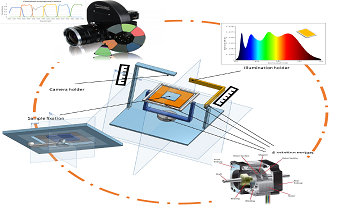
With the escalating demands for rendering technology, exclusive reliance on rendering programs is no longer sufficient. The collection of surface information pertaining to real-world materials has become a crucial aspect of computer graphics. The acquisition of material surface information is pivotal in the fields of digital reconstruction and virtual reality. In this article, we introduce a material acquisition device that employs multiple cameras and lights. This device utilizes a combination of multiple cameras and lights to capture objects from various angles and lighting conditions, resulting in more comprehensive and realistic material surface information. Specifically, the device features multiple cameras and strategically placed lighting. Four cameras are positioned at 10∘, 35∘, 60∘, and 85∘ to capture various aspects of the surface of the object while 24 point lights are placed in three layers of the hemisphere at 10∘, 35∘, and 60∘ with eight lights per layer spaced 45∘ apart. This approach facilitates the acquisition of rich and diverse material surface information by integrating multiple perspectives and lighting conditions.

This paper introduces a novel system for measuring the appearance of materials by capturing their reflectance represented by Spatially Varying Bidirectional Reflectance Distribution Function (SVBRDF) and Bidirectional Texture Function (BTF). Inspired by goniospectrophotometers, our system uses a fully-aligned and motorized turntable that rotates the sample around three axes to scan the entire hemispherical range of incident-reflection directions. The camera remains fixed while the light source can be rotated around one axis providing the fourth degree of freedom. To ensure high precision color measurement and spectral reproduction for reliable relighting purposes, we use a high-resolution multispectral camera and a broadband LED light source. We provide an overview of our instrument in this paper, and discuss its limitations to be addressed in the future works.

Bidirectional Texture Function (BTF) is one of the methods to reproduce realistic images in Computer Graphics (CG). This is a technique that can be applied to texture mapping with changing lighting and viewing directions and can reproduce realistic appearance by a simple and high-speed processing. However, in the BTF method, a large amount of texture data is generally measured and stored in advance. In this paper, in order to address the problems related to the measurement time and the texture data size in the BTF reproduction, we a method to generate a BTF image dataset using deep learning. We recovery texture images under various azimuth lighting conditions from a single texture image. For achieving this goal, we applied the U-Net to our BTF recovery. The restored and original texture images are compared using SSIM. It will be confirmed that the reproducibility of fabric and wood textures is high.

A system for simultaneously measuring surface normal vectors and BTF (bidirectional texture function) profiles of an object is proposed. This system consists of a correlation camera and a spherical scanning light source. The system can compress BTF measurement in one dimension of incidence direction to a single image frame, as well as measure a profile of the BTF under the scanning light source just from a single image frame. Experimental results on an implemented system demonstrate the feasibility of the proposed system.